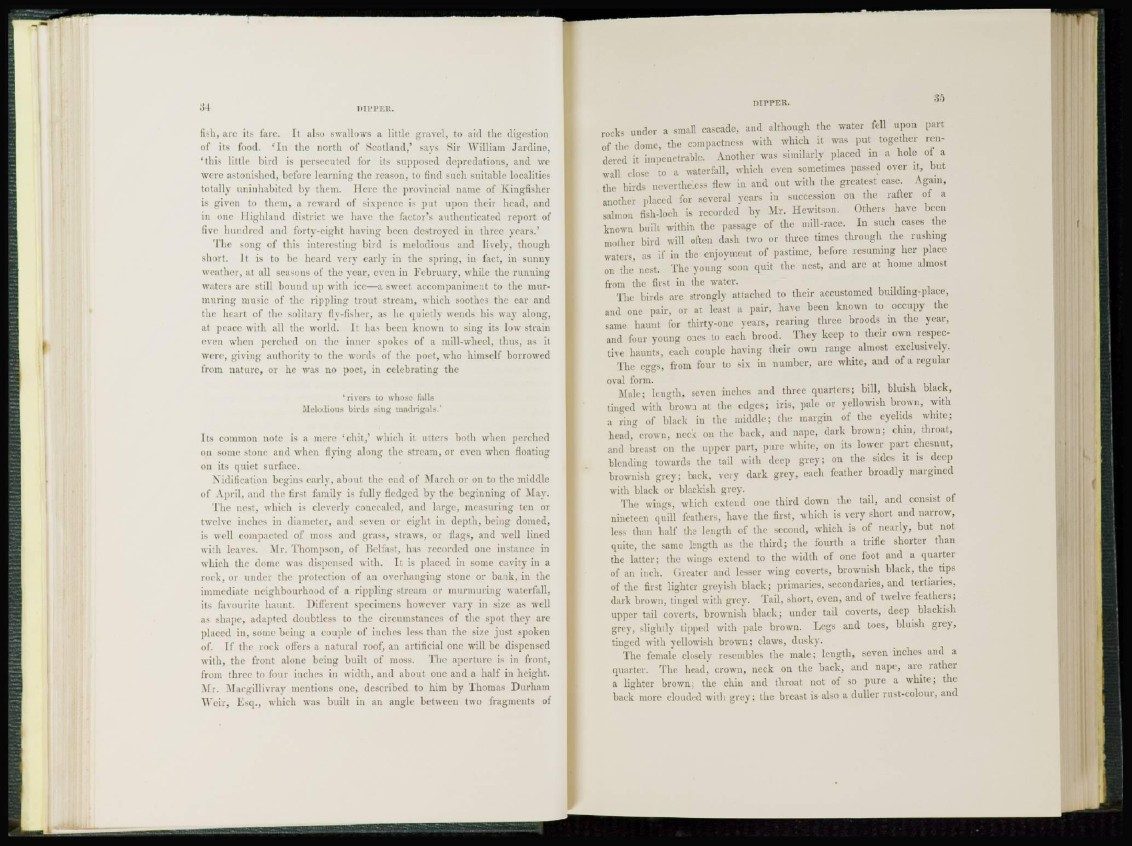
.11 DIPPER.
fish, are it- fare. Ii also swallows a little gravel, to aid the digestion
of its food. ' I n the north of Scotland,' says Sir William Jardine,
' t h i s little bird is persecuted for its supposed depredations, and we
were astonished, before learning the reason, to find such suitable localities
totally uninhabited by them. Here the provincial name of Kingfisher
is given to them, a reward of sixpence is put upon their head, and
in one Highland district we have the factor's authenticated report of
five hundred and forty-eight having been destroyed in three years.'
The song of this interesting bird is melodious and lively, though
short. It is to be heard very early in the spring, in fact, in sunny
weather, at all seasons of the year, even in February, while the running
waters are still hound up with ice—a sweet accompaniment to the murmuring
music of the rippling trout stream, which soothes the car and
the heart of the solitary fly-fisher, AS lie quietly wends his way along,
at peace with all the world. It has been known to sing its low strain
even when perched on the inner spokes of a mill-wheel, thus, SIS it
were, giving authority to the words of the poet, who himself borrowed
trom nature, or he was no poet, in celebrating the
'rivers to whose tails
Melodious birds sing madrigals
I t s common note is a mere ' c h i t , ' which it utters both when perched
on some stone and when flying along the stream, or even when floating
on its quiet surface.
N indication begins early, about the end of March or on to the middle
of April, and the tirst family U fully fledged by the beginning of May.
The nest, which is cleverly concealed, and large, measuring ten or
twelve inches in diameter, and seven or eight in depth, being domed,
is well compacted of moss and grass, straws, or flags, and well lined
with leaves. Mr. Thompson, of Belfast, has recorded one instance in
which the dome was dispensed with. It is placed in some cavity in a
rock, or under the protection of an overhanging stone or bank, in the
immediate neighbourhood of a rippling stream or murmuring waterfall,
its favourite haunt. Different specimens however vary in size as well
as shape, adapted doubtless to the circumstances of the spot they are
placed in, some being a couple of inches less than the size just spoken
of. If the rock offers a natural roof, an artificial one will be dispensed
with, the front alone being built of moss. The aperture is in front,
from three to four inches in width, and about one and a half in height.
Mr. Macgillivray mentions one, described to him by Thomas Durham
Weir, Esq., which was built in an angle between two fragments of
n i l 1 P E R.
rocks under a small cascade, and although the water fell upon part
of the dome, the compactness with which it was put together rendered
it impenetrable. Another was similarly placed in a hole of a
wall close to a waterfall, which even sometimes passed over it, but
the birds nevertheless flew in and out with the greatest case. Again,
another placed for several years in succession on the rafter of a
salmon fish-loch is recorded by Mr. Hcwitson. Others have been
known built within the passage of the mill-race. In such cases the
mother bird will often dash two or three times through the rushing
waters, as if in the enjoyment of pastime, before resuming her place
on the nest. The young soon quit the nest, and a r e at home almost
from the first in the water.
The birds arc strongly attached to their accustomed building-place,
and one pair, or at least a pair, have been known to occupy the
same haunt for thirty-one years, rearing three broods in the year,
and four young ones to each brood. They keep to their own respective
haunts, each couple having their own range almost exclusively.
' H i e eggs, from four to six in number, are white, and of a regular
oval form.
Male; length, seven inches and three quarters; bill, bluish black,
tinged with brown at the edges; iris, pale or yellowish brown, with
a ring of black in the middle; (he margin of the eyelids white;
head, crown, neck on the back, and nape, dark brown; chin, throat,
and breast on the upper part, pure white, on its lower part chesnut,
blending towards the tail with deep grey; on the sides it is deep
brownish grey; back, very dark grey, each feather broadly margined
with black or blackish grey.
'I he wings, which extend one third down the tail, and consist of
nineteen quill feathers, have the first, which is very short and narrow,
less than half the length of the second, which is of nearly, but not
quite, the same length as the t h i r d ; the fourth a trifle shorter than
the latter: the wings extend to the width of one foot and a quarter
of an inch. Greater and lesser wing coverts, brownish black, the tips
of the first lighter greyish black; primaries, secondaries, and tertiaries,
dark brown, tinged with grey. Tail, short, even, and of twelve feathers;
upper tail coverts, brownish black; under tail coverts, deep blackish
grey, slightly tipped with pale brown. Legs and toes, bluish grey,
tinged with yellowish brown; claws, dusky.
The female closely resembles the male; length, seven inches and a
quarter. The head, crown, neck on the back, and nape, are rather
a lighter brown; the chin and throat not of so pure a white; the
back more clouded with g r e y ; the breast is also a duller rust-colour, and